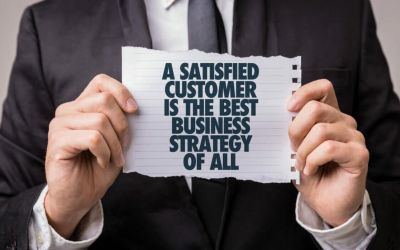6 Ways to Improve Customer Experience That You Can Strategize Today

The Importance of Customer Experience (CX)
As important as customer experience is, some can get it confused with customer success. Customer success covers activities and techniques to boost your customer’s satisfaction and keep their business after the buy or sale. On the other hand, customer experience is about creating a positive connection between your customers and your products, services, or brand. CX covers many strategies to ensure that your customers are satisfied each time they interact with your business.
COVID-19 had an immediate and worldwide impact on user behavior across all industries and demographics. As a result, many purchases have had to shift from brick-and-mortar and offline to online channels.
Expectations have shifted as priorities have changed to health and safety first. This, in turn, has changed decision-making and buying behavior.
And according to a recent report by KPMG, “63% of consumers say Value is the differentiator on product or service choice, as a result of COVID-19.” It also states, “The quality of customer experiences are improving around the world. All countries have seen an uplift in their Customer Experience Excellence (CEE) score this year. The average increase of all markets together is 3%.”
Customer experience reflects your customer’s interaction with your company. While a positive customer experience can be the catalyst for a loyal customer base, a negative one can influence the prospects even before they interact with your company.
How Can you Improve Customer Experience?
The secret to creating a great customer experience is to understand their journey first. Customer journey mapping, user personas, bringing in relevant information on your website, and optimizing your customer experience are ways to do it.
One of the essential elements to focus on is the digital customer experience. There has been a revolution in online shopping, buying, searching, and communicating. Because of this, it is optimizing your customers’ online experience is important.
To create an online environment, you need to make sure that you’re making a space that makes your visitors feel welcomed. For instance, Spotify engages its users by personalizing their playlists and listening histories. Not only for premium users but also for private usage. It makes its users feel valued as well as generates organic brand awareness.
All these steps should be taken your customer worries resolve faster. It’s good to have data about where your customers are likely to face obstacles. This will help your team run a smooth path and avoid any confusing pain points in the customer’s journey.
Then how to improve your customer experience? We have curated six critical areas that you can think of looking into right now.
1.Appreciation Emails
Email marketing, as the name suggests, goes beyond marketing. Emails are a great tool to bring excitement to your marketing strategy. You have access to an enormous amount of data, and how to use it?
The key is Personalization
Personalization can ensure and improve customer satisfaction. If you’re a B2B SaaS company, taking care of your email list ready would come in handy. When customers feel valued, companies gain measurable benefits, e.g., the chance to win more of their customers’ spending. You can do it in three ways:
Based on persona
Personalized appreciation emails make it one step closer to better customer service. Segmentations such as location, industry, job title, needs, and barriers can help in creating buyer personas.
Automated individualization
Using website behavior and download history, you can create different personas.
Personal
By tracking interactions and customers’ needs, you can solve the exact problem they want the solution for.
According to a report by Accenture, “91% of consumers shop with brands who recognize, remember, and provide relevant offers and recommendations.” That amounts to a considerable number. So next time when your favorite clothing brand sends you a personalized email to remind you about winter clothing, you’d connect the dots.
2.Customer Support
The use of psychology in marketing and market research isn’t new, and it can be used to understand your customer behavior and psyche better. If your organization is attempting to decode customer needs and wants, then they need to be able to connect and empathize with the situations that your customers come across.
Trend Spot your Customer
Your representatives are resolving many customer issues on a daily basis and to put some of the tickets to rest, you can address the recurring problems. By analyzing your customer support tickets, you’ll get ideas to improve the customer experience.
Customer experience management (CXM) is primary to create a streamlined customer experience. Adding small changes to your solution and service process not only keeps the older customers interested but also helps to attract new prospects, otherwise with the availability of too many options and information, customers lose interest. So, to prevent potential churn, it is essential to be present.
Customer Personas
Personas are based on your customer’s various attributes, triggers, barriers, and characteristics, demography. Buyer personas help you understand customers and prospects and tailor your support documents and interactions with customers further.
As long as it is important to create the ideal customer persona, it is also necessary to create negative buyer personas to make it clear with whom you don’t want to interact. Make sure your contact library is in place and as mentioned earlier trend spot what and how they consume or interact with your product, content, messaging.
Use your research data, past interactions data, and the data that you get from your gated content on the website, the data from your sales team who interacts and reaches out to the customers on a daily basis.
Customer Journey Maps
Once you have customer personas in place, the next logical thing is to create a journey map that tracks the stakeholder’s journey. To create highly effective personas it is important to align your business objectives to gain more insight regarding how to expand your solutions. Both primary and secondary research and real-time feedbacks help add changes and tweaks to your journey map. And in the end, make those journeys with memorable personas.
3.Rewards and Loyalty Points
Invesp reports that your existing customers are 50% more likely to try a new product of yours and spend 31% more than incoming or new customers. Hence, as we have been discussing, customer retention is the most important part of any present-day business.
Brands enable their frequent customers with loyalty programs to their to encourage loyalty and long-term business by offering free merchandise, rewards, recognitions, gift coupons, and sometimes giving early access to released products.
A rewards program can reinvent the loyalty life cycle. I also can make the customers feel empowered and valued when it is planned and implemented as part of the management strategy.
Let’s have a look at the ways how you can gather customer loyalty in different loyalty programs.
Point-based loyalty program
The points system is possibly the most common form of a loyalty program, but it isn’t applicable to all businesses. It works best for businesses that encourage short-term and frequent purchases. For example, your favorite organic shampoo brand is likely to carry out a point-based reward system that can later be redeemed for coupons and discounts.
Value-based loyalty program
Value-based programs are identifying your customers’ true requirements and offering them something that isn’t directly monetary benefit. Here you have to pay attention to your target audience’s behaviors than offer a coupon or discount voucher.
Gamify your program
Amazon has gamified some part of its customer retention process by adding regular quiz and jackpots. When you have a list of products, it’s an educative way to familiarize your features with your audience and later regarding them for their participation and knowledge. In addition, Gamification raises brand awareness by winning you some word-of-mouth and user-generated content on social media and similar third-party platforms.
4.Do chatbots improve customer experience?
You can integrate help desk software on your website by leveraging the power of Artificial Intelligence (AI). Intelligent automation trains itself with the type of questions that are asked.
The manual process related to this Q&A can be avoided by adding Value to the customer’s journey. In fact, it’s imperative to understand how Automation and AI are different.
With automation, you’re trying to re-route technology tasks that are typically done manually and are repetitive and prone to error. However, AI-based products and services are designed to imitate human behavior in terms of language, forms, intentions, and abstractions.
Several third-party services providers can do that for you if you don’t have an in-house team. While creating the workflows, keep Personalization in mind.
Keeping a human-centered approach can help create more robust workflows that can help serve the customers better. Along with FAQs, this software helps your customers with the additional and nuanced questions they might have about your product.
5.How do I Gather Customer Feedback?
Some marketers consider customer feedback as a great way to humanize your brand. Customer feedback helps your research design, packaging, product, features, usability, and reliability.
In other words, everything which are the building blocks of customer experience. Low cost and ease of modification make surveys one of the marketer’s favorites for measuring past and present customer behaviors. Email-based surveys are preferred to paper-based or physical discussions because they can be more easily shared, and they give the surveyor the flexibility to modify and analyze easily.
Even for the customers that are going to churn, try to find out their reasons to move on. It can be done by providing multiple channels for customer feedback. To create a better experience, when they come back or for your incoming customers, past patterns can really add on values.
There are several ways to measure customer feedback.
NPS(Net promoter score)
Commonly used to measure customer loyalty, NPS is the difference between the percentage of detractors and promoters. This shows the organic brand advocates you have. Although it can be difficult to understand how good or bad it is because of its wide range, it is highly correlated to customer loyalty and growth.
CSAT(Customer satisfaction score)
CSAT questions are asked at the end of live chats or knowledge base articles/blogs to understand how helpful the solution was for the customer. It’s short and is set with emojis, stars, or just simple numbers.
Social media monitoring
This one is the most exciting way to reveal how your brand is performing. You can check several channels you’re in; Quora, Facebook, Twitter, and other third-party review sites. It’s a great way to get to the new customer trends, understand sentiments, and analyze how they react to your product and content.
6.Use real-time analytics to create an amazing experience
Innovative ideas are imperative to improve Customer Experience, and that happens when you continuously evolve with your customer. There are many user experience analytics tools in the market to understand your customer’s journey better. And the wholesome insight comes from adding up the qualitative and quantitative research together.
Here are a few examples of how you can do it:
User flow maps
A complete visual representation of a user’s journey gives a journey map from landing on your page to purchasing something from your website. Another way to achieve a similar result is by session recording the user’s session.
Heatmap analytics
This gives a visualization of parts of a page that are getting the most interaction by color-coding the ‘heat’ gradient on web pages to indicate click activity.
Real-time analytics
This shows the real-time actions taken on your page. For example, you can find individual user journeys and the number of current visitors on your page.
The Bottom Line
Customer experience improves when it becomes a top priority and an inseparable part of the company’s work culture. With the availability of tools and information, you can apply the best of the strategies, but a solution can bring only in a human-centered way.
Technology is only an enabler.
As Amazon founder Jeff Bezos says, “We see our customers as invited guests to a party, and we are the hosts. It’s our job every day to make every important aspect of the customer experience a little better.” It’s all about finding the right mix of best practices and understanding what your customer thinks, feels, and observes.


